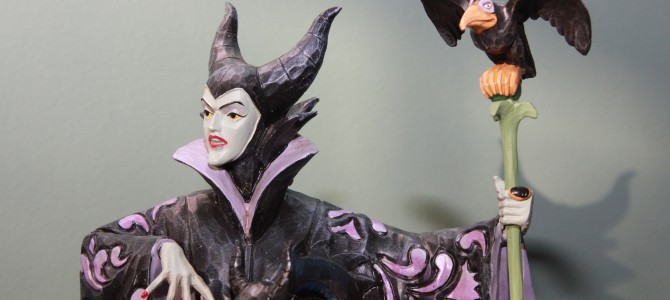
Editor’s note: Spoilers below.
“Listen up, young women. All men want to do is cut off your wings and use you. Period. They are incapable of love, either as husbands or as fathers. So if you ever want to fly in life, you must separate from them.” That seems to be the underlying message of Disney’s just-released, feminist-preachy movie “Maleficent,” starring Angelina Jolie. It’s all supposed to retell “Sleeping Beauty” from Maleficent’s point of view. But it feels more like a political tract.
The original character of Maleficent, which was created for the 1959 Disney animated feature “Sleeping Beauty,” has long intrigued me. As a young girl, Maleficent captivated me unlike any witch I had ever seen before. She was so elegant in her evil, so stunning a presence with those startling twisted horns.
But I was mostly fascinated by the story of Sleeping Beauty in its entirety. It’s a timeless allegory about the mystery of love and the union between a man and a woman. The original archetypes hold a real enchantment that this reinvented Sleeping Beauty tale lacks. The archetypal union between the man and the woman, you see, was threatened by forces perpetually trying to separate them. In 1959, Maleficent represented the forces trying to isolate a man and woman so that they wouldn’t join together. Gee, Maleficent, seems you haven’t changed a bit!
Jolie claimed in an interview that this story respects the classic. That’s just false. “Maleficent” is an abortion of the classic, clearly at war with its deepest allegory about the union of humanity as male and female. When you strip away the polished gloss of special effects and action, all that’s left is an old-fashioned feminist propaganda screed.
It’s laden with ideals professed by Marxism and hard-core environmentalism, too. The fairies in the moors live in perfect harmony and trust with each other and the environment—but that’s another story for another time.
‘Why Can’t a Man Be More Like a Woman?’
If there is a central message “Maleficent” delivers to its young audiences, it is this: Men are incapable of “true love” towards women. This is evinced by three elements in the movie: its flat male characters; its re-interpretation of “true love’s kiss;” and its complete elimination of the male-female union as anything good or ever necessary.
“Maleficent” lacks a single complex male character. The men in the movie are either: a) comic book villains like King Stefan and company; b) buffoonish and weak, like Prince Phillip; or c) creatures invented by Maleficent who exist to serve her. The latter would be Diaval, the raven whose life Maleficent saved by turning it into a man.
Stefan starts out as a petty thief, and by the end he is depraved. Maleficent begins as a kind-hearted, just, and trusting fairy who eventually becomes defender of her fairy homeland, the moors. Stefan becomes her human boyfriend, with whom she shared “true love’s kiss” on her 16th birthday. But he inexplicably leaves her. She pines for him while he follows a path of greed and ambition, as all men presumably do.
One day Stefan returns to warn Maleficent that the greedy, ambitious and violent human king—who seeks to plunder “the moors and its treasures”—intends to have Maleficent killed. He does not mention that the king has promised the throne to whoever slays her.
The trusting and smitten Maleficent forgives Stefan for his various follies. They snuggle together in reconciliation and an appearance of love. Then Stefan drugs her and she falls unconscious. When he can’t bring himself to kill Maleficent, he brutally severs her beautiful and glorious wings to take back to the king. Thus Stefan is rewarded with a crown, and Maleficent is moved to revenge and hatred, cursing King’s Stefan’s new baby daughter, Aurora.
Stefan is impervious to the love of women, as lover, husband, or father. He won’t go to his wife on her deathbed, because he’s too obsessed over the battle against Maleficent. When daughter Aurora returns and embraces him for the first time, Stefan does not reciprocate. He’s busy plotting with associates around a table. And, true to feminist stereotype, he treats Aurora as chattel to lock up so Maleficent can’t get to her.
The message about fatherhood in this story is that fathers are not only unnecessary, but sources of evil. The only motherhood, as we shall see, is single or surrogate motherhood.
‘True Love’s Kiss’
Even without wings, Maleficent is far more powerful than any mere man. She defeats armies at will, renders men unconscious with a wave of the finger, summons dragons, and so on. Men cower in her presence.
This power is further evidenced in “true love’s kiss” that can awaken Aurora from her sleeplike death. With the help of Maleficent, Prince Phillip the Brainless is brought in for “the kiss,” since he happened upon Aurora once and fell in love. When three bumbling fairies urge, “Just kiss her!” Phillip kneels over and eventually does.
But it doesn’t work. So much for the guy.
Then Maleficent, overcome with grief, admits how she was “lost in hatred and revenge,” and lightly kisses Aurora’s forehead. Lo and behold, Aurora wakes up to greet her “fairy godmother.” And Diaval, watching, says on cue that this was, indeed, “true love’s kiss.”
Of course, Maleficent is the reason Aurora is lost in the death-sleep, since she took revenge on Stefan by cursing his innocent baby to die on her 16th birthday. The method of death is the same as in the original tale: Aurora pricks her finger on the spindle of a spinning wheel, an apt feminist symbol for the drudgery of spinning and weaving work traditionally done by women.
The only thing that can break the spell is “true love’s kiss,” which, of course, does not exist in Maleficent’s mind, because true love would mean respecting the whole woman and her aspirations to fly high in her own right. But, sure enough, in this version “true love” exists in Maleficent, who had bonded with Aurora as she secretly watched over her with morbid curiosity in infancy and childhood.
In essence, Maleficent steals the child of the wicked King Stefan, raising Aurora from the shadows. Maleficent takes pleasure in influencing Aurora, and through her wiles, takes ownership of her. She places a sleeping Aurora in the moors to wake up to its enchantments and its pleasures. Aurora is spellbound, and her loyalty to Maleficent is complete. In the final battle, Aurora helps Maleficent destroy her evil father and takes up a sort of sisterhood bond.
The worlds of fairies (female) and humans (male) are then “unified,” but not really. The humans are brought under fairy domination. It’s the only way, you see. Maleficent brings down her fearsome wall of thorns separating the lands only after she has conquered the humans. All is on Maleficent’s terms because there is nothing redeemable about humans, i.e., men, in this story.
So Maleficent conquers the forces of evil, as personified by King Stefan. Then Maleficent wins the damsel.
All this after imposing her will as queen over the once-free fairies, after driving the king to more depths of insanity by cursing his child, and with him Aurora’s bystander mother,who dies in grief after Maleficent takes ownership of Aurora, after finally killing Aurora’s father. Maleficent wins it all. She “has it all.” Even gets her wings back. She’s more like Stefan than Stefan, it seems. Checkmate.
Forget this Man-Woman Thing
Providing a same-sex ending to the Sleeping Beauty story—whether the relationship is maternal, sisterly, or even erotic—requires that the male-female union, which is central to the original allegory, be completely eradicated. It abolishes any understanding of humanity as coming in two kinds, male and female, that can unify in mutual self-sacrifice. “Maleficent” dismantles this understanding of marriage.
Child psychologist Bruno Bettelheim, in his book The Uses of Enchantment: The Meaning and Importance of Fairy Tales (1975), revealed a fascinating reversal of sex roles that exists in classic Sleeping Beauty themes. These are exchanges and unions impossible if we are to accept the same-sex ending of Maleficent as the only one who could awaken Aurora by “true love’s kiss”:
. . . in ‘The Sleeping Beauty’ it is the prince who observes the sleeping girl, but in ‘Cupid and Psyche’ and the many tales derived from it, it is Psyche who apprehends Cupid in his sleep, and, like the prince, marvels at the beauty she beholds. This is just one example. Since there are thousands of fairy tales, one may safely guess that there are probably equal numbers where the courage and determination of females rescue males, and vice versa.
Furthermore, the kiss of Maleficent is meant to be ambiguous. It doubtless serves as an introduction that “true love”—which is universally understood to have a sexual component—can mean many things, except for one. The male-female union receives the kiss of death in this reinvention of “Maleficent.” It might also serve as the LGBT-agenda’s version of the “Tree of Knowledge.” We’re allowed to pick any kind of “love” from its garden of earthly delights, except for one. We are under no circumstances permitted to think or talk about the fact that humanity comes in two kinds—male and female —and that marriage happens when they unite in mutual self-sacrifice. To utter such a thing makes you a bigot.
Prince Phillip: Archetype vs. Stereotype
The 1959 Disney cartoon portrayal of Prince Phillip offered a balanced view of what a male can aspire to in terms of honor and goodness. There is no such balance or even hope for him in the new “Maleficent” story. The 1959 Phillip was also more respectful and reverencing of Aurora than the reinvented caricature of him offered in “Maleficent.”
Consider the 1959 Phillip’s perception of Aurora’s different station in life. He met her while she was in hiding and thought she was a peasant. Yet that didn’t matter to him. Phillip startles his father by opting out of a planned marriage to a princess, determined instead to marry a peasant he met.
Of course, Aurora was really a princess. But Phillip didn’t know that and neither did he care. It was Aurora—the whole woman—whom he loved. And he was willing to sacrifice and fight for her. That portrayal was a standard to hold men to. No more.
Also in the 1959 version, when Phillip and Aurora meet, they realize that they actually know each other and have met many times in their dreams. The ideal conveyed is that of being known by our “other half” and coming together in mystical union and mutual self-sacrifice. Bettelheim describes this “true love’s kiss” as something that awakens us to the other and “breaks the spell of narcissism.”
In the Disney classic, Mary Costa cast as Aurora, and Bill Shirley cast as Phillip, sang passionately and joyously to the Tchaikovsky melody with the words: “I know you. I walked with you once upon a dream . . .” By contrast, the “Maleficent” movie uses an eerie rendition of this song during the end credits. It’s sung, as though somewhat nauseous, by Lana del Rey.
The classic fairy tale also shows that being a princess simply means having all the qualities of Aurora—innocence, purity of heart, kindness, empathy, cheerfulness. You could be a peasant and a princess at the same time. And being a prince meant the same thing: Seeing the whole person in the one you love, and appreciating who she is without regard to her station in life and how she might affect your status or career ambitions. In this way, the original Disney classic is a more egalitarian tale than “Maleficent.”
Hail, ‘Quing’ Aurora
In the end, Maleficent crowns Aurora queen of the united lands. But despite her princess-y and feminine looks, might it be less sexist and more accurate in this gender neutral version to say she’s a “quing,” an amalgam of queen-and/or-king?
One can only wonder how much heavier a dose of gender bending we’ll get if this “Maleficent” produces sequels. The air is filled with hints. Consider the May 29 cover story of Time magazine, welcoming us all to a pretty pushy transgender future. And Secretary of Defense Chuck Hagel is calling for a review on the ban of transgender individuals in the military.
Consider also that Disney executives recently provided red carpet publicity to a drag Maleficent, who greeted Angelina Jolie at the premier. Nice touch.
It all feels like “Maleficent” is a little harbinger of a new “trans” juggernaut. There’s lots of diversity and potential for shape-shifting and transmogrifying in Maleficent’s fairy land. And the land of the humans unites with the moors of fairy land under Maleficent’s watchful eye.
So, we’ll see. (Remember, this manufactured gender identity revolution intends to redefine the humanity of us all. Just read about the ENDA legislation already passed by the Senate which codifies as fact that our sex is merely “assigned at birth.”)
On the surface, Aurora looks very much the princess. But she’s an agent for “Maleficent’s” feminist agenda. If you are going to teach girls who pine for the idea of true love with a man to not even aspire to it, you must use the imagery of a traditional princess as your mouthpiece.
If you want the next generation to trash “traditional” ideas of love and instead adapt to an ideology such as the environmental-feminist-Marxism concoction espoused in “Maleficent,” you must deceptively deliver your message through someone who looks and acts like the Princess Aurora in this film: traditional, innocent, happy, trusting, kind, beautiful. She serves as what Cass Sunstein would refer to as a “surprising validator.”
Then, you must add a dose of moral relativism into the batch: We learn that peace does not come to the land a hero or a villain, but only by Maleficent, who was both hero and villain.
Finally, the narrator, who speaks throughout in a subtly wizened voice of feminist wisdom, identifies herself. She is Aurora, the one they called “Sleeping Beauty.”
In the end, Disney’s new Maleficent is no redeemer. In fact, she owns Disney now. And it seems she’s even more a creature of deception and betrayal than ever.









